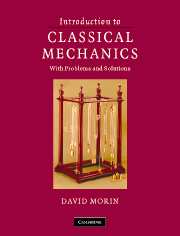Book contents
- Frontmatter
- Contents
- Preface
- 1 Strategies for solving problems
- 2 Statics
- 3 Using F = ma
- 4 Oscillations
- 5 Conservation of energy and momentum
- 6 The Lagrangian method
- 7 Central forces
- 8 Angular momentum, Part I (Constant L^)
- 9 Angular momentum, Part II (General L^)
- 10 Accelerating frames of reference
- 11 Relativity (Kinematics)
- 12 Relativity (Dynamics)
- 13 4-vectors
- 14 General Relativity
- Appendix A Useful formulas
- Appendix B Multivariable, vector calculus
- Appendix C F = ma vs. F = dp/dt
- Appendix D Existence of principal axes
- Appendix E Diagonalizing matrices
- Appendix F Qualitative relativity questions
- Appendix G Derivations of the Lv/c2 result
- Appendix H Resolutions to the twin paradox
- Appendix I Lorentz transformations
- Appendix J Physical constants and data
- References
- Index
Appendix G - Derivations of the Lv/c2 result
- Frontmatter
- Contents
- Preface
- 1 Strategies for solving problems
- 2 Statics
- 3 Using F = ma
- 4 Oscillations
- 5 Conservation of energy and momentum
- 6 The Lagrangian method
- 7 Central forces
- 8 Angular momentum, Part I (Constant L^)
- 9 Angular momentum, Part II (General L^)
- 10 Accelerating frames of reference
- 11 Relativity (Kinematics)
- 12 Relativity (Dynamics)
- 13 4-vectors
- 14 General Relativity
- Appendix A Useful formulas
- Appendix B Multivariable, vector calculus
- Appendix C F = ma vs. F = dp/dt
- Appendix D Existence of principal axes
- Appendix E Diagonalizing matrices
- Appendix F Qualitative relativity questions
- Appendix G Derivations of the Lv/c2 result
- Appendix H Resolutions to the twin paradox
- Appendix I Lorentz transformations
- Appendix J Physical constants and data
- References
- Index
Summary
In Section 11.3.1, we showed that if a train with proper length L moves at speed v with respect to the ground, then in the ground frame the rear clock reads Lv/c 2 more than the front clock (assuming that the clocks are synchronized in the train frame). There are various other ways to derive this result, so for the fun of it I've listed here all the derivations I can think of. The explanations are terse, but I refer you to the specific problem or section in the text where things are discussed in more detail. Many of these derivations are slight variations on each other, so perhaps they shouldn't all count as separate ones, but here's my list:
1. Light source on train: Put a light source on a train, at distances d f = L(c − v)/2c from the front and d b = L(c + v)/2c from the back. You can show that the photons hit the ends of the train simultaneously in the ground frame. But they hit the ends at different times in the train frame; the difference in the readings on clocks at the ends when the photons run into them is (d b − d f )/c = Lv/c 2. Therefore, at a given instant in the ground frame (for example, the moment when the clocks at the ends are simultaneously illuminated by the photons), a person on the ground sees the rear clock read Lv/c 2 more than the front clock.
- Type
- Chapter
- Information
- Introduction to Classical MechanicsWith Problems and Solutions, pp. 704 - 705Publisher: Cambridge University PressPrint publication year: 2008



